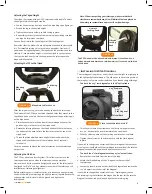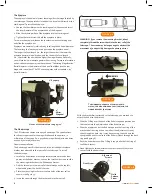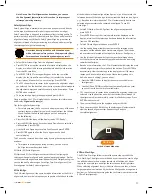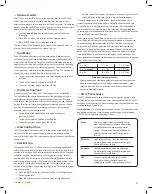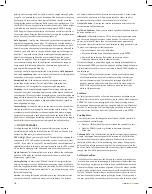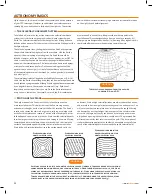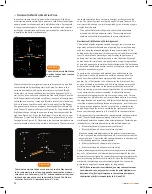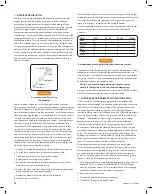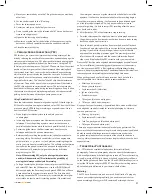
>>
www
.celestron
.com
15
>>
Scope Setup Features
Setup Time-Site – Allows the user to customize the CPC display by
changing time and location parameters (such as time zone and
daylight savings) .
Anti-backlash – All mechanical gears have a certain amount of backlash
or play between the gears . This play is evident by how long it takes for a
star to move in the eyepiece when the hand control arrow buttons are
pressed (especially when changing directions) . The CPC’s anti-backlash
feature allows the user to compensate for backlash by inputting a value
which quickly rewinds the motors just enough to eliminate the play
between gears . The amount of compensation needed depends on the
slewing rate selected; the slower the slewing rate the longer it will take
for the star to appear to move in the eyepiece . There are two values for
each axis, positive and negative . Positive is the amount of compensation
applied when you press the button, in order to get the gears moving
quickly without a long pause . Negative is the amount of compensation
applied when you release the button, winding the motors back in the
other direction to resume tracking . You will need to experiment with
different values (from 0-99); a value between 20 and 50 is usually best
for most visual observing, whereas a higher value may be necessary
for photographic guiding . Positive backlash compensation is applied
when the mount changes its direction of movement from backwards to
forwards . Similarly, negative backlash compensation is applied when the
mount changes its direction of movement from forwards to backwards .
When tracking is enabled, the mount will be moving in one or both axes
in either the positive or negative direction, so backlash compensation will
always be applied when a direction button is released and the direction
moved is opposite to the direction of travel .
To set the anti-backlash value, scroll down to the anti-backlash option
and press ENTER. While viewing an object in the eyepiece, observe the
responsiveness of each of the four arrow buttons . Note which directions
you see a pause in the star movement after the button has been pressed .
Working one axis at a time, adjust the backlash settings high enough to
cause immediate movement without resulting in a pronounced jump
when pressing or releasing the button . Now, enter the same values
for both positive and negative directions. If you notice a jump when
releasing the button, but setting the values lower results in a pause when
pressing the button, go with the higher value for positive, but use a lower
value for negative . CPC will remember these values and use them each
time it is turned on until they are changed .
Slew Limits – Sets the limits in altitude that the telescope can slew
without displaying a warning message . By default the slew limits are set
to 0º to 90º and will only display a warning message if an object is below
the horizon . However, the slew limits can be customized depending on
your needs. For example, if you have certain photographic accessories
attached to your telescope preventing it from pointing straight-up,
you can set the maximum altitude limit to read 80º, thus preventing
the telescope from pointing to any objects that are greater than 80º in
altitude without warning .
Slew limits are applied relative to the base of the mount not the
actual horizon. So when setting the slew limits when using the
telescope on an equatorial wedge, remember that a minimum
slew limit of 0° would prevent the telescope from slewing down
past the celestial equator not the horizon. To set the slew limit so
that the telescope will slew to the horizon while on a wedge, you
must set the minimum slew limit to equal your latitude minus 90°.
Filter Limits – When an alignment is complete, the CPC automatically
knows which celestial objects are above the horizon. As a result, when
scrolling through the database lists (or selecting the Tour function),
the CPC hand control will display only those objects that are known to
be above the horizon when you are observing . You can customize the
object database by selecting altitude limits that are appropriate for
your location and situation. For example, if you are observing from a
mountainous location where the horizon is partially obscured, you can
set your minimum altitude limit to read +20º. This will make sure that
the hand control only displays objects that are higher in altitude than
20º. If you manually enter an object that is below the horizon using the
numeric keypad, the hand control will display a warning message before
slewing to the object.
If you want to explore the entire object database, set the
maximum altitude limit to 90º and the minimum limit to –90º.
This will display every object in the database lists regardless of
whether it is visible in the sky from your location.
Direction Buttons – The direction a star moves in the eyepiece varies
depending on the accessories being used . This can create confusion when
Содержание 11007
Страница 1: ...InstructionManual 11007 11008 11009...
Страница 2: ...www celestron com...
Страница 40: ...38 www celestron com APPENDIXD MAPSOFTIMEZONES...
Страница 41: ...www celestron com 39...
Страница 42: ...40 www celestron com APPENDIXE SKYMAPS...
Страница 43: ...www celestron com 41...
Страница 44: ...42 www celestron com...
Страница 45: ...www celestron com 43...
Страница 46: ...44 www celestron com...
Страница 47: ...www celestron com 45...





